The following is a description of an eight-day bushwhacking adventure into some of the most remote areas within the Five Ponds Wilderness in the northwestern Adirondacks. The trip includes traversing areas of intense blowdown along the oddly-shaped Oven Lake, exploring a cluster of wilderness ponds and following the wild Robinson River. Part one of the final day is a hike southwest along a marked trail from Wolf Pond to Sand Lake.
Section Stats:
Date: July 5, 2011
Length: 2.7 miles (2.7 miles for the day)
Difficulty: Easy
A hermit thrush greets me with its flute-like song at the beginning of my last day in the wilderness. The sun is still not above the horizon but the darkness’s hold on the surrounding forest is quickly weakening. In the dim light, the hermit thrust appears in front of the lean-to, apparently in search of an early breakfast of invertebrates.
Hear the hermit thrush’s etheral song at Wolf Pond.
View Day Eight, Part One in a larger map
Soon a single pine warbler and several least flycatchers join their songs to the scant morning chorus. The song of these two species nearly drowns out all other bird songs, due to their loudness and proximity to the lean-to. Down on the pond, a common loon calls occasionally, not wanting to be left out.
Hear the pine warbler and least flycatchers singing at Wolf Pond.
While lying in my Western Mountaineering Highlite sleeping bag, I hear the sound of something scrambling on the roof of the lean-to. My imagination runs wild: perhaps the fisher is back, or deer mice are amassing in an effort to reoccupy the lean-to.
Although curious about the identity of my visitor on the roof, I remain in my comfortable and warm sleeping bag. I know I should be getting up and preparing for my exodus from the Five Ponds Wilderness, but instead I continue to observe the awaking forest in front of the lean-to.
While lying there procrastinating on my return to civilization, a couple of American robins arrive. The male stays on a low branch of a young red maple, preening himself, only stopping briefly to occasionally belt out a song. By contrast, the female hops along on the ground collecting pieces of dead grass and other debris, most likely for a nest currently under construction.
When the female discovers a nice clump of grass situated at the base of the lean-to, her elation is palpable. She pulls at the clump repeatedly, favoring the dead grass to that of the living. She signals her approval with an occasional squeak despite her beak being completely filled with the grassy nesting material.
When she can no longer fit anymore grass in her beak, she suddenly flies off into the white pines. The male, with his beak empty, follows in hot pursuit. Apparently the roles taken on by the two sexes are not all that dissimilar between different species in the animal kingdom after all.
After leaving the lean-to and preparing my breakfast, I head down to the water’s edge with my Leica compact binoculars and Olympus DSLR camera in hand. I take numerous photographs from the end of the trail before bushwhacking a short distance to the east for more pictures at the edge of the swampy inlet.
The inlet is broad, mostly open, wetland. Filled with numerous shrubs and small snags, it is typically active with birds. Numerous male red-winged blackbirds are scattered about, singing to mark their nesting territories. Several rusty blackbirds fly about, occasionally giving their song, a decent impersonation of a creaky metal gate. There is no evidence of the American bittern that used to call repeatedly here or along the opposite shore back in the late nineties.
Upon returning to the lean-to, I pack up my Golite Pinnacle backpack for the 6+ mile hike back to my car on Bear Pond Road. While in the lean-to, I am startled by a sudden, loud staccato tapping on the roof. After walking around the outside of the lean-to, I flush off a single female hairy woodpecker. Based on the struggle she has clinging to a nearby tree, she might be an immature fledgling from this year, despite the adult appearance.
By a little past eight in the morning, I begin my hike out of the wilderness after a short but pleasing visit to the outhouse located behind the lean-to.
On my way back to the intersection with the Five Ponds and Sand Lake Trails, I flush up a thrush from right next to the trail. It moves in such a flash there is no way to identify it to species. A quick search in the vegetation yields a finely constructed nest. The nest is well-camouflaged in a clump of herbaceous vegetation just off the trail. How did I miss it on the way in yesterday? I do my best to take a few pictures without disturbing the vegetation and then quickly resume my trek on the trail.
Upon reaching the intersection, I take a right and head southwest toward Sand Lake.
After hiking through mostly hardwood forest, the trail goes through a wet area before arriving at the rocky crossing of the Wolf Pond inlet stream. The stream is thin and swift as it weaves its way through many boulders and rock outcroppings before cascading down an aggressive slope creating an unimpressive waterfall.
The crossing is much easier than the last time I was here. At that time, I tried crossing after a heavy rain over night and the slippery rocks forced me to detour way upstream. Instead of detouring upstream now, I jump over the flowing water and down to a slanted rock on the far side of the stream, causing an eastern phoebe to fly downstream from a nearby tree branch.
The trail climbs a short but very steep section right after the stream crossing before returning to a mature mixed forest. Wolf Pond lies down slope and to the west, often visible through the trees. The trail continues along the slope often meandering around several wet areas caused by the 1995 Microburst. A new trail section detours around some of the worst wet areas, probably to avoid the slick rocks exposed by the tip-up mounds after the storm.
I pass the point where I left the trail to head to Streeter Fishpond on the second day of this trip. After this point the trail goes through a series of ups and downs as it edges closer to Wolf Pond’s southeastern shore. After crossing a small stream, the trail leaves behind the pond as it continues to the southwest toward Sand Lake.
The trail continues through mature mixed forest the rest of the way to Sand Lake. The trail remains dry except for a few flooded low places where I take care not to get wet feet on my last day in the backcountry. The trail cuts across an occasional swath of new growth, more evidence of the intense 16-year old windstorm. A large black bear scat lies next to the trail; its decaying condition indicates it is not recent.
When an open boggy wetland to the south becomes visible, I know Sand Lake is nearing. Only a few minutes later along the trail, the towering white pines surrounding the lean-to area become visible up ahead.
The lean-to site is not in as good condition as when I left it on day two of this trip. Obviously, some occupants failed to practice proper lean-to etiquette. Numerous pieces of junk (i.e. pieces of rope, aluminum foil, etc.) lay strewn around on the floor of the lean-to, while garbage was flung into the fireplace. After cleaning up the entire site, I noted the untidy condition in the register.
I discard my backpack in the lean-to as I plan on taking a break at Sand Lake before continuing on via the herd path in back of the lean-to. My break at Sand Lake and the rest of my hike to my car continues in the final part of my trip report appearing here soon.
Affiliate Disclaimer: Some links within this blog post may send you to a retailer website. If you chose to purchase any product at that site at that time the author will receive a small commission. These commissions provide compensation for the author’s time and effort necessary to provide the content at the Bushwhacking Fool.
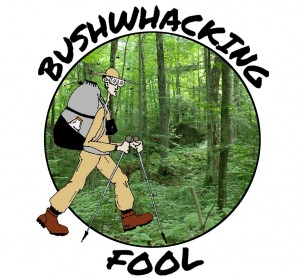
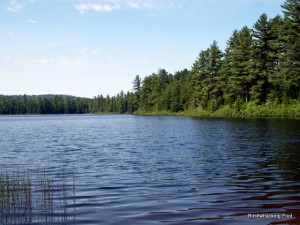
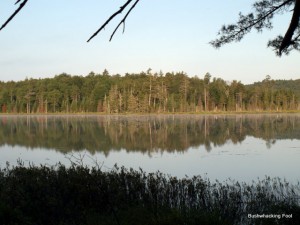
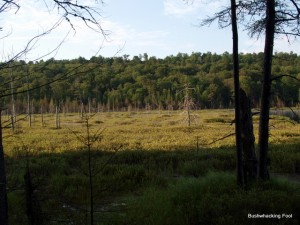
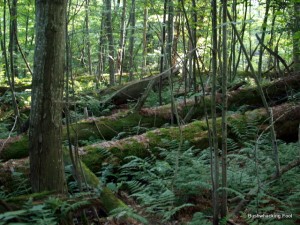
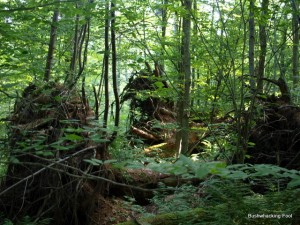
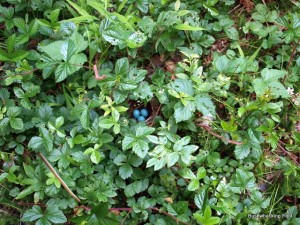
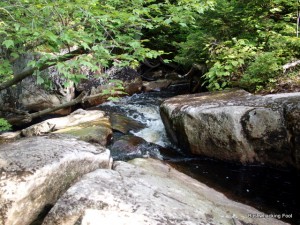
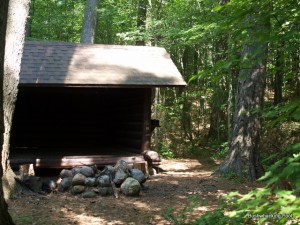




Kurtis Lanning
February 6, 2020 at 4:34 pm
Hi there,
I’d like to pick your brain about access to sand lake etc.
I met a few guys paddling down the Oswegatchie last year in passing, and asked where they had come from. As I remember it, they said something like, bear pond road, and sand lake. So I’ve spent some time thinking how exactly one might come from that direction. I haven’t come across any good maps, or descriptions of the area except for this blog you have here.
If you had any advice to give that would be great, since you’ve walked the terrain maybe you know about paddling too.
I think I’ve found bear pond rd, but its not labeled on google maps. anyway it looks like one could begin a paddle (up?) the middle Oswegatchie where bear pond rd is just east of Buck pond. From there turn up the Sand Lake Outlet and paddle about 3 miles to Sand Lake.
From there maybe you could carry the mile and a half to wolf pond, and paddle out the outlet towards big five, with what looks like plenty of pulling over beaver dams and such in the process. eventually continuing on to little five, another outlet and finally the Oswegatchie
I figure these guys must have done it that way, and wonder what the paddle up sand lake outlet would be like and if there’s a marked trail from sand lake to wolf pond, and what a portage might look like in that respect.
I’ve done the Lows Lake to Oswegatchie 3.5 mile carry, so I don’t think this one would be more difficult.
Any thing that can give me a clue as to the how the connectors might be for paddling, and where a trail might be would be a great help!
Thanks!
bushwhackingfool
February 6, 2020 at 11:24 pm
Hey Kurtis,
I’ll get back to you on this in a couple days. I’ll either put it here in the comments or perhaps I’ll send it in an email.
By the way, Bear Pond Road is labeled as Adirondack Park Preserve on Google Maps (it seems that is their default for any road they don’t know the name of in the Adirondack Park). It is the continuation of Long Pond Road, which is correctly labeled, so look for that road and follow it east. When you see a large parking lot on the satellite imagery, that is the beginning of Bear Pond Road. The parking lot is just east of the Oswegatchie Education Center.